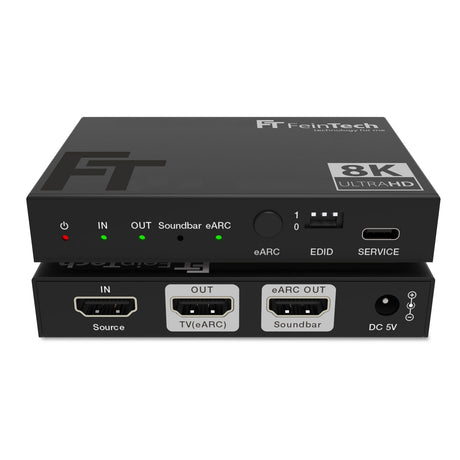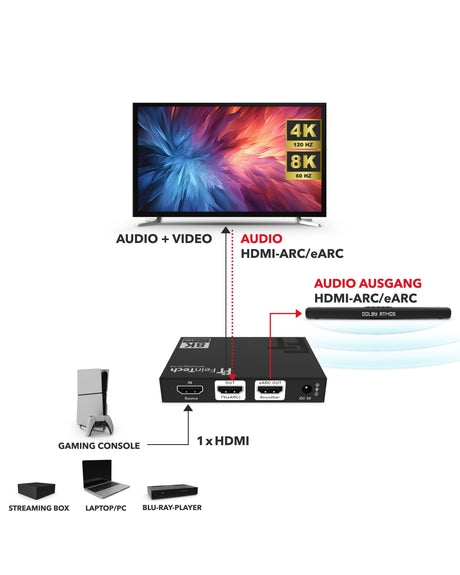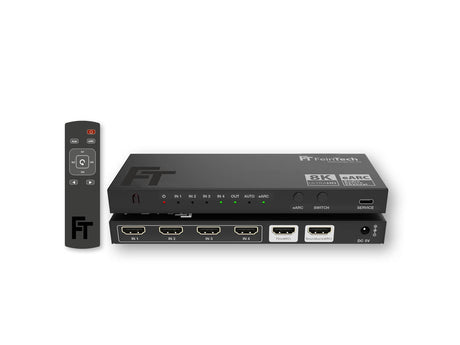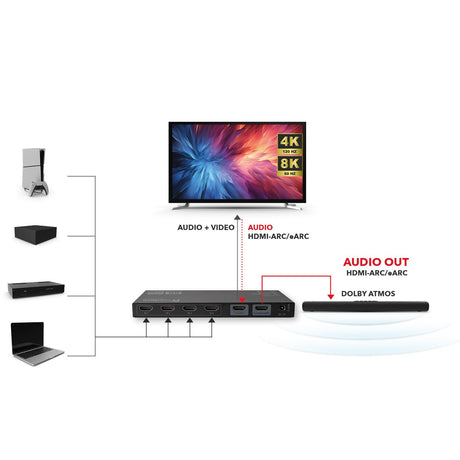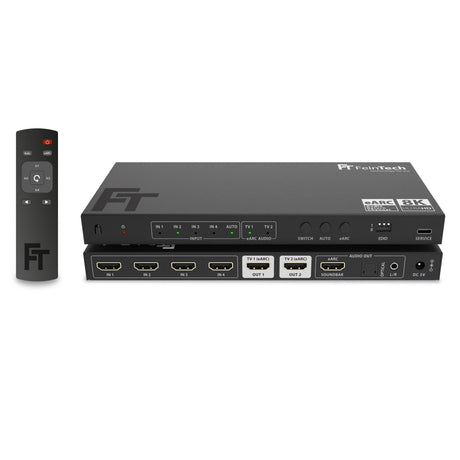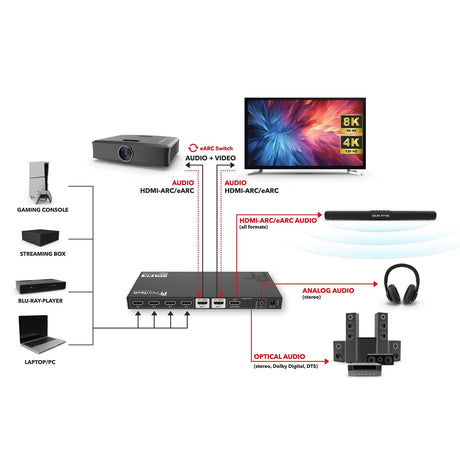More and more soundbars also support higher sound formats such as Dolby Atmos. Dolby Atmos can only be transmitted via HDMI and no longer via SPDIF audio connection. SPDIF (with Toslink or coaxial cinch connection) allows a maximum of Dolby Digital / DTS 5.1 in bitstream format. The bandwidth is not sufficient for more than that.
Of course, all soundbars with Dolby Atmos support have at least one HDMI port. There are two ways the signal is transmitted:
HDMI or HDMI-ARC / HDMI-eARC
The audio-video signal is transmitted via HDMI from a source (streaming box, PC, game console, TV receiver) to the HDMI sink (TV, projector, AV receiver). The HDMI source has an HDMI output and the sink has an HDMI input. Most soundbars are equipped like an AV receiver and can be connected between the source and sink. The soundbar has 2 HDMI connections, one or more inputs and an HDMI output.

The HDMI Audio Return Channel (ARC) has been around for almost 10 years. The advantage: If the soundbar supports ARC, the audio signal path can also be used in reverse. The output of the soundbar is connected to the HDMI ARC input of the TV. The TV then delivers the sound to the soundbar in the opposite direction. The internal TV speakers switch off and you can hear the sound from cable TV, apps and other HDMI sources via the sound system.
The soundbar is connected to the TV input with its HDMI output, and the sound comes back in the opposite direction. You can easily understand this if you switch to the HDMI input on the TV to which the soundbar is connected. Either the soundbar menu will be displayed or simply a pattern.
HDMI-ARC limitations and possibilities
There are a few challenges when connecting via ARC:
- Some TVs only deliver stereo sound from external sources via HDMI-ARC and no surround sound. It is unclear whether this is a design flaw in the chipset or a cost-cutting measure.
- ARC was specified to transmit the same formats as SPDIF. So a maximum of DTS and Dolby Digital 5.1. Technically, however, more is possible. Many TVs from LG Since around 2016, including all Dolby Vision TVs, they have been able to output Dolby Digital Plus (DD+) via ARC. Services such as Netflix, Amazon Prime, Sky and Disney use DD+ to transmit Dolby Atmos. Many Samsung TVs have also been able to output DD+ since 2019. Some TVs from other manufacturers have also extended the ARC specification and deliver Dolby Atmos.
- HD audio formats such as Dolby True-HD and DTS HD Master Audio or uncompressed multi-channel sound PCM5.1 / PCM7.1 cannot be transmitted via ARC at all - only by the successor standard eARC in soundbars from 2020. These formats are usually found on Blu-Ray or computer games.
- There are streaming boxes like Apple TV, that do not output the audio as a bitstream. Instead, the multi-channel sound is decoded in the box and transmitted on separate audio channels. Advantage: Operating sounds such as clicks and Siri can be used during film playback. Disadvantage: Multi-channel PCM cannot be transmitted via HDMI-ARC. This only works with very new HDMI 2.1 TVs and eARC. The output on the Apple TV can be switched to "Dolby Surround" so that an ARC-compatible bitstream with Dolby Digital 5.1 is output. With many TVs, there is a chance that this will be transmitted via HDMI-ARC. However, this does not work for DD+ / Dolby Atmos. The same applies to an Xbox.
- Google Chromecast or Fire TV Lite, on the other hand, deliver either stereo or DD+. These streaming adapters do not support "normal" Dolby Digital 5.1 in most apps. TVs without DD+ support therefore only output stereo to the soundbar.
- More on the topic: ARC and HDMI-CEC (used for volume control)
If you want to use the highest sound quality from Apple TV, Xbox, PC, Nintendo Switch or Chromecast, you can only do this on a sound system with a "real" HDMI input or via HDMI-eARC. If the soundbar only has a single HDMI connection, this is always an HDMI output that supports ARC or eARC.
Conclusion:
Soundbars with ARC or eARC and only a single HDMI connection depend on the capabilities of the television. These include Sonos Arc, Sonos Beam and Bose Soundbar 500, 700, 900. Such soundbars cannot be operated with an HDMI splitter because there is no "real" HDMI input. Connecting to a video projector is also made more difficult.
We have therefore developed special HDMI switches to which such soundbars can be connected via HDMI. The VAX04101 model is used to connect 3 HDMI sources to an HDMI-eARC soundbar and a display. It supports all sound formats including Dolby Atmos via HDMI-eARC. The VAX04201 version is designed for 2 screens (e.g. TV and projector).


